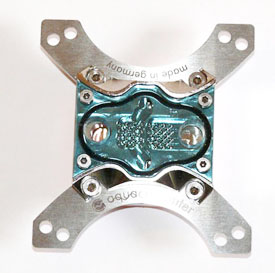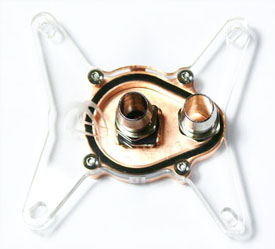
If you missed part one of this series, you can find it here.
The answer is, not half as much as we think we do – a look through the cooling portions of the forums can give you a good indication that familiarity does not equal knowledge. That doesn't mean we don't know anything – it just means that we take some simple things for granted, and we maybe don't have a grasp of some of the finer mechanics of what's going on under the hood.
Nowhere is this truer than in the case of the waterblock itself. Although they are a source of continual debate, the principles behind their design are often ignored, with discussion focusing instead on the block of which leading industry professional (like Danger Den, Aqua Computer and D-Tek) to use. But why do their blocks work so well? And whose block is the best?
Well, we may not get to whose is the best... that's a review article which is in the works. But we can look at their anatomies to understand why they work so well, and even what we can do to replicate some of those successes if we were to want to do it ourselves.
 Well, sort of... not really. But yes... no.
Well, sort of... not really. But yes... no.
Why the confusion? Well, this is a huge misconception. Let's rephrase this properly: A waterblock obtains temperature equilibrium with the heat spreader of the underlying chip. That's it. No sucking involved.
It's the same misconception as air cooling – a heatsink doesn't actually cool the chip. It simply provides a greater surface area for the heat to spread over. Since there's more metal to heat up, there's less heat in each molecule of metal – so it seems like it's cooling. The real definition of cooling is the removal of heat from the system – no heat is being removed here, just simply spread out. Instead, it's the fluid—be it air or water—that actually does the cooling.
This probably seems pedantic – the block cools, or the block spreads the heat and thus lowers temperature. It may seem the same, but it's not – it radically changes how we need to look at water blocks. We can distil everything above down to one basic statement:
A block's function is not to cool your CPU – it's to provide the most contact with water molecules as possible.

Introduction
Watercooling is something that many of us at bit-tech are familiar with. However, how much do we really understand what's going on underneath the plastic and metal of our hoses and blocks?The answer is, not half as much as we think we do – a look through the cooling portions of the forums can give you a good indication that familiarity does not equal knowledge. That doesn't mean we don't know anything – it just means that we take some simple things for granted, and we maybe don't have a grasp of some of the finer mechanics of what's going on under the hood.
Nowhere is this truer than in the case of the waterblock itself. Although they are a source of continual debate, the principles behind their design are often ignored, with discussion focusing instead on the block of which leading industry professional (like Danger Den, Aqua Computer and D-Tek) to use. But why do their blocks work so well? And whose block is the best?
Well, we may not get to whose is the best... that's a review article which is in the works. But we can look at their anatomies to understand why they work so well, and even what we can do to replicate some of those successes if we were to want to do it ourselves.
The very, very basic stuff
So, before we get into that, let's take a look at what a waterblock actually does and how it works. I suppose the first part is easy – a waterblock sucks heat from the CPU, right?
The Aqua Computer Cuplex XT is
the best low-flow block on the market.
Why the confusion? Well, this is a huge misconception. Let's rephrase this properly: A waterblock obtains temperature equilibrium with the heat spreader of the underlying chip. That's it. No sucking involved.
It's the same misconception as air cooling – a heatsink doesn't actually cool the chip. It simply provides a greater surface area for the heat to spread over. Since there's more metal to heat up, there's less heat in each molecule of metal – so it seems like it's cooling. The real definition of cooling is the removal of heat from the system – no heat is being removed here, just simply spread out. Instead, it's the fluid—be it air or water—that actually does the cooling.
This probably seems pedantic – the block cools, or the block spreads the heat and thus lowers temperature. It may seem the same, but it's not – it radically changes how we need to look at water blocks. We can distil everything above down to one basic statement:
A block's function is not to cool your CPU – it's to provide the most contact with water molecules as possible.
OK... So?
The above may seem like a simple statement, but it defines a huge part of what makes a good block. Let's take a look at what we can draw from this concept alone:
The TDX by Danger Den is a popular
and very effective high-flow block.
- Bigger is not better: A giant chunk of copper may be able to pull heat from the spreader, but it means nothing when it comes to getting the copper connected to the water. Think of a giant chunk of copper with nothing more than a 1/4" trough cut into it – the only actual cooling is coming from that trough. The rest of the block is wasted, as air is considerably less efficient than water.
- Winners have ridges: If copper to water contact ration is the most important thing, then surface area is paramount. Thus, ridges, fins, or other obstructions will dramatically increase the cooling potential, just like in a traditional heatsink. In fact, the only downside is the amount of pressure needed to overcome all of the obstructions (something we'll get into in a moment). So get over that idea of a "fast" block, where water flows uninterrupted to do the most loops possible – that method is a myth anyway.
- Equilibrium is everything: As the copper block and CPU heatspreader strike equilibrium, so will the block and the water – there will be a permanent differential between the block temp and the water temp due to insulation, though, known as the thermal resistance. The closer that these two are to one another, the better the block is at doing its job.
- Positioning matters: Since the block is there to do nothing but disperse heat, it's going to have colder and hotter portions – nothing is perfectly uniform, and heat radiates from the point of contact. The hottest spot will be right over the CPU die, so having the most surface area and the most water flow over that spot will provide the best cooling.

MSI MPG Velox 100R Chassis Review
October 14 2021 | 15:04








Want to comment? Please log in.